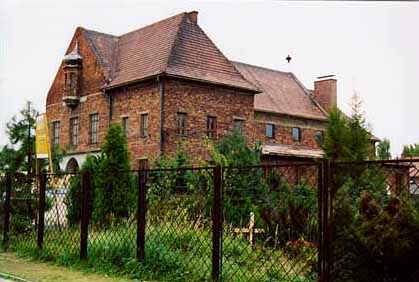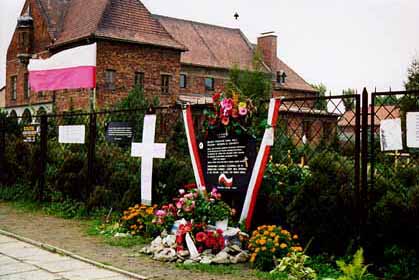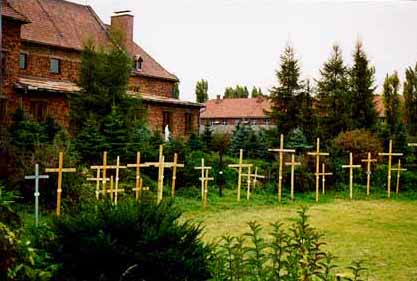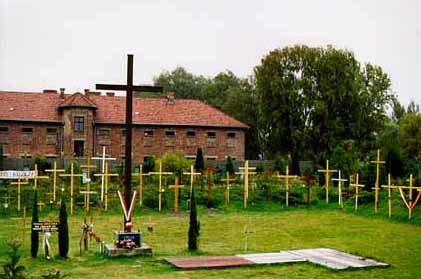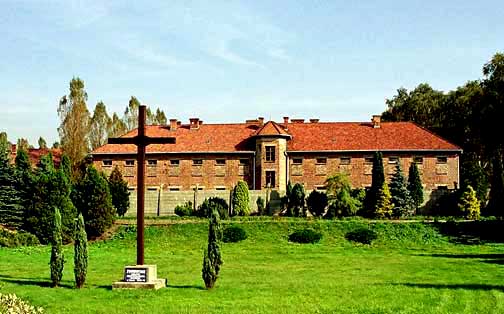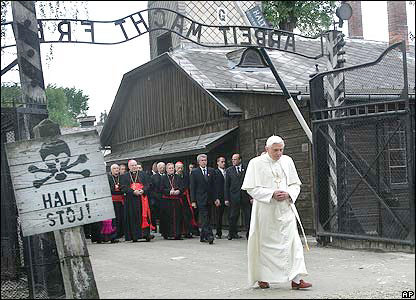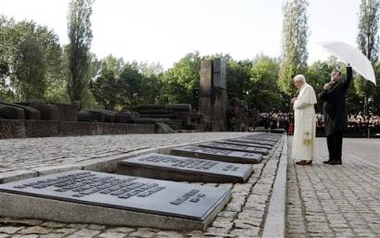The 1998 War of the
Crosses
or
Whose Holocaust is
it, anyway?
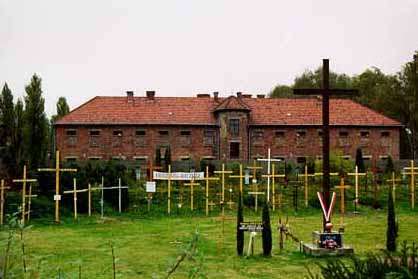 Crosses put up in 1998
in front of Block 11
Crosses put up in 1998
in front of Block 11
In 1998, Polish nationalists embarked
upon a mission to put up 152 Christian crosses in honor of the
Polish Catholic resistance fighters who were executed by the
Nazis in a gravel pit behind Block 11 at the main Auschwitz concentration
camp. This was their way of protesting Jewish demands, over the
previous 10 years, that the 26-foot souvenir cross from a Mass,
said by the Pope at Birkenau, be removed. The basic attitude
of the Poles, as expressed to me, was "This is our country.
You have your country and we have ours. If we want to put up
a Catholic Cross in our country, we'll put it."
It was Kazmirierz Switon, a Polish citizen, who began the crosses campaign in August 1998. The crosses were removed on May 28, 1999, and peace was restored. The place where the crosses were set up was right next to the building where Carmelite nuns had set up a convent. At that time, the plot of land where the crosses were set up had been leased to a non-profit "save the cross" group that wanted to save the Pope's cross, which the Jews wanted removed.
Graffiti on billboards along the route
to the Auschwitz camp in 1998 alerted visitors to the War of
the Crosses before they even reached the camp. The graffiti that
I saw was light-hearted and joked about the controversy, even
mentioning Winnie the Pooh. When I was there in October 1998,
the War of the Crosses had escalated to the point that the Polish
Catholics were threatening to put up over 1,000 crosses, or one
for each year that Poland has been Catholic territory. During
the years when Poland had ceased to be a country, it was the
Catholic Church that kept the spirit of Polish nationalism alive.
Jewish protests against Christian symbols
were increasing in 1998, and there was a new demand that the
Catholic Church in the former SS administration building at Birkenau
be removed because it is not appropriate at the place where over
a million Jews perished in the gas chambers.
In October 2005, when the photo below
was taken, a Catholic Church was still in this building.
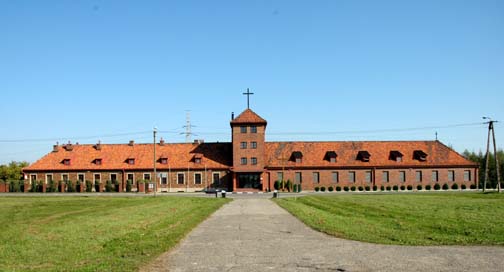 Catholic Church in
former SS administration building at Birkenau
Catholic Church in
former SS administration building at Birkenau
The War of the Crosses was the culmination
of years of tension between the Poles and the Jews. The Jews
are still resentful that some of the Poles collaborated with
the Nazis during World War II, and even worse, after the war
in 1946, there were pogroms in which more Jews were killed by
Polish civilians. The Jews say that the Nazis killed the Jews
because they were acting under orders, but the Poles killed the
Jews because they wanted to. As late as 1968, there was violence
against the Jews in Poland, and even today Jewish memorials and
Synagogues in Warsaw must be constantly guarded against vandalism
and arson.
The desire of the Jews is to make Auschwitz
an international site, rather than a place under the control
of the Polish government. Jewish students come from Israel, and
from other countries all over the world, for a bi-annual event
called the "March of the Living" and at this time,
they meet and talk informally with Polish students in an attempt
to understand the past and to prevent future bloodshed.
Auschwitz is the world's largest Jewish
graveyard. It was here that over a million innocent Jews lost
their lives at the hands of the Nazis. The very name Auschwitz
is synonymous with Jewish suffering and genocide. So why would anyone ever want to put up Christian
crosses at Auschwitz? Worst of all, why would anyone put up crosses
just outside the grounds of a Holocaust Memorial Site, where
they might be seen by Jewish mourners praying inside?
The photograph below shows Block 11,
the prison building at the main Auschwitz camp with the execution
wall, called "the black wall," on the left. A person
standing here in October 1998 would not have been able to see
the crosses that were erected in the gravel pit on the other
side of this building.
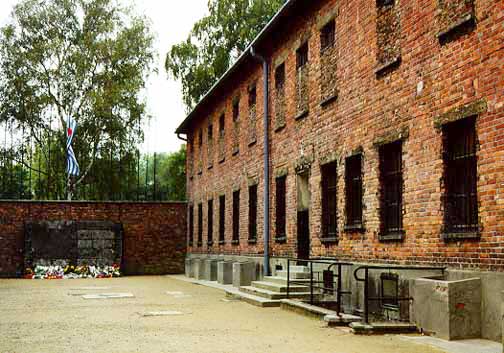 The other side of the
Block 11 building, taken from inside the camp
The other side of the
Block 11 building, taken from inside the camp
Actually, the place where most of the
Jews perished in the Holocaust is not at the Auschwitz main camp,
called Auschwitz I, outside of which Christian crosses were placed
in 1998, but at Auschwitz II, a huge subsidiary camp, 3 kilometers
from the Auschwitz I camp. Auschwitz II is better known as Birkenau,
and the whole camp complex is now called Auschwitz-Birkenau.
Every school child in America knows about
the Holocaust and the fate of Anne Frank, who died of typhus
at Bergen-Belsen, where she was transferred after being a prisoner
at Auschwitz-Birkenau. The place where Anne Frank was sent was
actually Auschwitz II, now called Birkenau. Birkenau is the German
name for the village of Brzezinka where the camp for Jewish prisoners,
brought from all over Europe, was located. It was at Birkenau
that the genocide of the Jews was carried out, not at the main
camp where the crosses were placed.
To understand the War of the Crosses,
from the viewpoint of Polish nationalists, one needs to understand
that the former Nazi concentration camp at Auschwitz I, which
has been turned into a museum, is called the Museum of Martyrdom,
suggesting a non-denominational connotation. When the main Auschwitz
camp was first turned into a museum in 1947, the official decree
read, "On the site of the former Nazi concentration camp,
a monument to the martyrdom of the Polish nation and of other
nations is to be erected for all time to come." There was
no mention of Jews or the Holocaust in any of the official Museum
guidebooks at that time. The Museum was intended to be strictly
political, a monument to the struggle of the Communists against
the Fascists. The Museum was officially described as an "International
Monument to Victims of Fascism."
It was only after the fall of Communism
in 1989 that the genocide of the Jews was even mentioned on the
monument in the former Birkenau camp. Before 1989, few people
from outside Poland had ever seen Auschwitz-Birkenau, but there
were actually more visitors during the Communist regime than
there were in 1998 because all Polish citizens were encouraged
to go on group tours of the camp and most of these visitors were
Catholic. In 1998, the largest group of visitors were the Polish
Catholic high school students who were fulfilling an educational
requirement to visit Auschwitz where so many of their Catholic
grandfathers suffered and died bravely during the Polish resistance
to the Nazi occupation.
From the first day that the Auschwitz
main concentration camp opened in June 1940, it was the place
where Polish political prisoners were sent. It was Catholic religious
pictures that were laboriously scratched with fingernails onto
the concrete walls of a basement prison cell at Auschwitz by
Polish resistance fighters who were imprisoned there. It was
mostly Catholic political prisoners who were led naked to the
black wall at Auschwitz and executed with a shot in the neck.
It was mug shots of Polish Catholic prisoners that lined the
walls of the corridors in 1998 in the former camp buildings at
Auschwitz that have been converted into a museum.
For the Polish people, who are 98% Catholic,
Auschwitz-Birkenau is the place where not one, but two, of their
Catholic saints died as martyrs. Both Father Maksymilian Kolbe,
a Catholic priest, and a Carmelite nun named Edith Stein met
their deaths at Auschwitz-Birkenau and have been canonized as
Catholic saints. The prison cell in Block 11 at the Auschwitz
main camp, which was occupied by Father Kolbe who volunteered
to die to save the life of a fellow prisoner, is a prominent
Catholic shrine. In 1998, the controversial crosses were placed
in front of the side wall of the Block 11 building, where Father
Kolbe was imprisoned in a "starvation cell."
Pictured below is the inside of the basement
cell where Father Kolbe was left to die. On the wall is a memorial
plaque. This cell is always decorated with fresh flowers, but
notice that there is no cross here, as this building is inside
the main Auschwitz camp, which is now a museum.
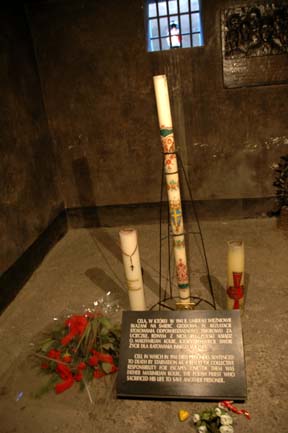 2005 photo of Prison
Cell No. 18, Father Kolbe's cell
2005 photo of Prison
Cell No. 18, Father Kolbe's cell
Edith Stein was born a Jew and was an
atheist, but converted to the Catholic religion and became a
Carmelite nun under the name of Sister Benedicta of the Cross.
Because she was a Jewess, she was gassed in the gas chamber in
the little cottage known as Bunker 2 at Birkenau on August 9,
1942; she was canonized a saint in the Catholic Church in October
1998.
The original War of the Crosses began
in 1979 after pious Catholics erected a Christian cross at the
ruins of Bunker 2, following the announcement by the Pope that
the Church was initiating the beatification process, the first
step toward sainthood. Jews then erected a Star of David symbol
and soon there was a proliferation of crosses and stars: the
war had begun.
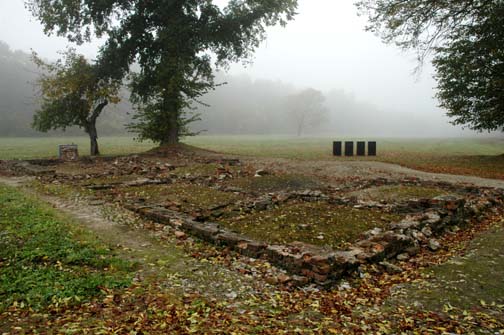 2005 photo of the ruins
of Bunker 2
2005 photo of the ruins
of Bunker 2
The original War of the Crosses ended when an agreement was reached in May 1997 and signed in December 1997 between Jewish leaders and Polish leaders. The agreement stated that no religious, political or ideological symbols would be placed at Auschwitz-Birkenau. The papal Cross, used by Pope John Paul II when he said Mass at Birkenau, was exempted in the agreement. The Jewish leaders did not approve of this exemption and in 1998, the new War of the Crosses began.
It was the Carmelite nuns who had placed the papal cross at the Auschwitz main camp in 1988, near their convent which was just outside the walls of the camp. The Carmelite convent had been established in 1984 in a brick building, which was formerly used by the Nazis to store the Zyklon-B pellets that were used for gassing the Jews. There is also a Carmelite convent just outside the walls of the former Dachau concentration camp, and the Christian cross on the top of it is within sight of, and only a few yards from, the Jewish Memorial which was built at a later date. The convent at Dachau has an entrance through one of the former guard towers at the camp and it is open to tourists who are visiting the former concentration camp.
The Jews have also protested against the Dachau convent, but to no avail. It was still there when I visited in May 2007, along with a Protestant Memorial Chapel and a Catholic Memorial Chapel on the grounds of the former camp. There are no crosses or Christian symbols of any kind atop the memorial chapels at Dachau, although the nearby Jewish Memorial has a Menorah on top and a Star of David on the entrance gate.
Protests about the convent at Auschwitz
were more effective and finally the hierarchy of the Catholic
Church agreed to evict the nuns from the building. The controversy
became even more heated in the summer of 1989 when the nuns failed
to meet the deadline for moving. Local residents reacted furiously
when Jewish activists from the USA and Israel staged a series
of protests at the site. The Poles interpreted the protests as
a hostile foreign intrusion and an assault on the sovereignty
of the Polish nation by the governments of other countries. The
nuns finally moved to new quarters across the street in 1993,
but left behind the cross from the Pope's mass, which they had
erected near their convent.
Poland became the premier country for
the world's Catholics because it was the birthplace of Karol
Wojtyla, the Cardinal-Archbishop of Krakow, who was elected in
1978 as the first-ever Polish pope and the first non-Italian
pope in 450 years. The birthplace of John Paul II is only 30
kilometers from Auschwitz in Wadowice, a small and once obscure
town that has become a popular place of pilgrimage for pious
Catholics. Wadowice now has an international airport to handle
the many visitors to the town.
On June 7, 1979, Cardinal Wojtyla came
back to Poland, as Pope John Paul II, and honored the country
of his birth by saying Mass at the former Nazi concentration
camp at Auschwitz II or Birkenau. Birkenau was chosen because
it is the closest place to the Pope's home town that was large
enough to hold the crowd of 500,000 people who attended this
unique event in the history of Catholic Poland.
The 26-foot cross from the altar of that
Mass is the same cross that was erected by the Carmelite nuns
in 1988 at their new convent in a building just outside the grounds
of the Museum of Martyrdom at Auschwitz I. The building that
the nuns moved into had formerly been a theater before World
War II.
The pictures below, taken in 1998, represent
a panoramic view of the scene of the controversy about the crosses.
The first picture starts at the left of the scene and shows the
former building occupied by the Catholic Carmelite nuns; the
other pictures were snapped from left to right as you take in
the whole area of the crosses. Shown in the last two pictures
is the brick building inside the camp, called Block 11, where
Father Kolbe was imprisoned. On the other side of Block 11 is
the infamous black wall where many Polish Catholic prisoners
were shot. On the spot where the large cross now stands, 152
Polish Catholics were shot. The gas chamber where Jews and Russian
Prisoners of War were gassed between January 1942 and March 1942
is on the opposite side of the camp, as far away as you can get
from the place where the crosses were erected in 1998.
|
